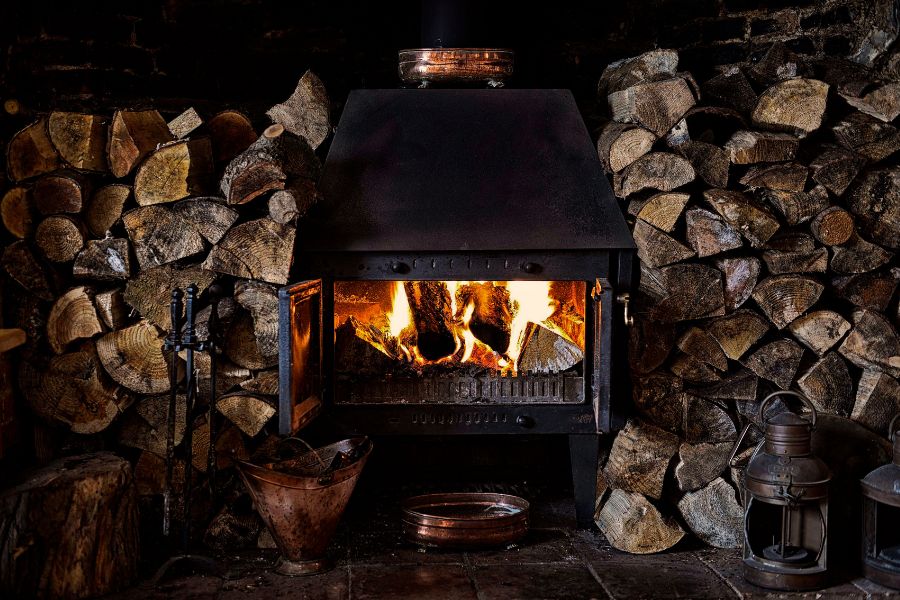Rules On How to Use Log Burner Vents
Wood-burning stoves are pretty popular. In fact, it has been, for centuries, painting scenes of crackling fires and glowing embers in countless homes. Yet, while many appreciate the warmth of a wood burner, not everyone knows how to use log burner vents effectively. These vents, essential components of wood-burning stoves, affect how efficiently wood burns. When you operate these vents like a pro, you can optimize their wood burners. That’s a surefire way to make a hearty fire that heats the room and paints that picturesque scene we all cherish.
Let’s walk you through how to use log burner vents.
We also have some guides to help you keep your mattress clean, maintain perfect storage in your bathroom, and inspire your next front door.
What are Stove Air Vents?
Every wood burner relies on an air supply to sustain its flames- that’s how vital vents are. At its core, the primary air vent, often located beneath the stove door, introduces air that fans the initial flames, giving life to the fire.
It’s this vent that starts the ballet of burning wood, controlling the amount of airflow that enters the wood burner. A secondary air supply becomes crucial as the wood burns and the fire crackles. This air, introduced through different vents, reinvigorates the fire, ensuring unburned gases find their fiery fate and contribute to the stove’s heat.
What’s the Role of Vents in Combustion
A lot of factors affect how well your wood-burning stove works. Minor mistakes or some negligence may lead to issues like chimney fires. Hence, maintaining the optimum burning temperature is the primary factor that ensures wood burns best. Achieving this temperature maximizes heat output and reduces the risk of creosote build-up—a leading cause of chimney fires.
Understanding how a log burner vents is integral to maintaining this temperature. The vents control the amount of room air that can enter the wood stove, influencing the fire’s intensity.
When the ducts are wide open, cold air rushes in, providing more oxygen, which, in turn, fuels the flames. However, too much air may cause the wood to burn quickly, requiring you to add more wood frequently. Too little air will smother the fire, reducing its heat output and efficiency.
How Does Stove Air Vents Work?
If you want to use a log burner, you need to gain mastery over its vents, especially in the delicate balance between hot air and cold air. The multi-fuel stove, a close cousin of the wood stove, offers a glimpse into the complexities of this balance. Both systems rely on vents to control airflow, but the latter has the added challenge of accommodating various fuel types.
With a fire burning vibrantly inside, it’s tempting to keep the air vents open and let the flames soar. However, doing so can cause the stove to overheat, leading to an inefficient burn and increasing the risk of a chimney fire. On the other hand, closing the vents too much might stifle the fire, leading to incomplete combustion.
The magic lies in understanding the cues. Wood burns best when it has consistent access to air, but not so much that it’s consumed rapidly. Observing the flames, understanding the fire sounds, and feeling the heat output will guide you in making micro-adjustments to the vents.
Air Supplies in Stoves
A wood-burning stove isn’t just about lighting wood and watching as the fire burns. It’s about supplying air at the right moments to ensure all the wood combusts effectively, giving the desired warmth. This balancing act of air supply dictates how much heat the stove produces and how long the wood lasts.
As we’ve touched on before, the primary air gives life to the initial flames. This air supply enters through vents located mainly below the combustion chamber. This rush of oxygen breathes vigor into the embers, turning them into a robust flame. However, that’s only part of the story.
Beyond primary air, stoves often integrate an air wash system, which supplies additional airflow over the glass door. Not only does this prevent soot and tar from settling, but it also contributes to the overall combustion process. It optimizes heat output and prevents the rapid build-up of harmful residues.
How to Operate Primary Vents
It’s an experience many stove owners know well: eagerly stacking up logs, striking a match, and being disappointed when the fire doesn’t meet expectations. The culprit? More often than not, it’s mishandling the primary vents.
Using a wood stove is beyond knowing where the primary vent is. When you begin, open the direct vent to allow a generous air supply, setting the stage for a vigorous fire. As the fire establishes, this vent will guide the tempo, dictating how fiercely the fire burns and ensuring that all the wood is used optimally.
Mastering the primary vent means being attuned to the stove’s needs, adjusting the intake to prevent chimney fires, and ensuring maximum efficiency. Through vigilant observation and a touch of experience, one can glean when to introduce more air or when to restrict. That way, you can make every log count and draw out the maximum warmth.
How to Use Secondary Vents
The crackling of a log fire can be music to the ears. But maintaining its rhythm demands a certain finesse—enter the role of the secondary vent. If the primary vent lays the foundation for a fire, the secondary vent ensures it reaches the crescendo of efficient combustion.
Unlike open fireplaces, where the heat can easily escape, and the fire’s whims are primarily dictated by external conditions, a log burner’s enclosed environment allows for precise control. Here, the secondary vent introduces pre-heated air into the chamber. This reignites unburned gases, ensuring minimal waste and more heat from each log. And it also helps maintain the operating temperature at an optimum level.
What are the Safety Precautions and Tips?

Maintenance is King
A wood burner requires regular upkeep. So, ensure vents are free from soot, dust, and any obstructions that could inhibit airflow. A clean vent boosts efficient combustion and plays a crucial role in preventing chimney fires.
Listen to the Fire
A sharp hissing might indicate too much moisture in the wood, while a dull, muted roar could hint at a need for more air. Pay attention to the fire to promote safety at all times.
Stay Vigilant
Never leave a roaring fire unattended. While the beauty of a log fire can be hypnotic, it’s essential to remain conscious of its potential risks and act swiftly should anything seem amiss.
Ready to Get Your Log Burner Vents
Through the ages, we’ve evolved from open campfires beneath starry skies to the intricate log burners of today, controlling and fine-tuning the very essence of combustion. Yet, the principle remains the same: a harmonious dance of wood, air, and flame.
Mastering log burner vents is not just about extracting the maximum heat or achieving efficient combustion. It’s about understanding each step and, in doing so, creating moments that resonate with warmth—both literally and figuratively.

